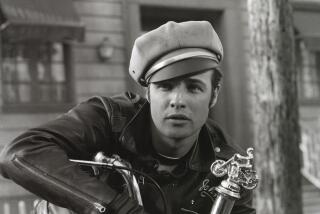Cannes Film Festival: Walter Salles’ journey to ‘On the Road’
CANNES, France — Walter Salles carefully raises the fingers of his right hand and gently strokes the back of his left.
“These are characters,” he says, explaining the gesture, “who experience things not vicariously but on the flesh. Men and women in a quest for something they couldn’t define yet, who are trying to amplify their knowledge of the world.”
More than half a century after “On the Road” was published, 30-plus years since Francis Ford Coppola bought the rights in 1978, and nearly a decade after Salles began working on the film, Jack Kerouac’s peerless anthem to the romance of youthful freedom and experience has finally made it to the screen with its virtues and spirit intact.
Having its world premiere in competition at Cannes on Wednesday, Salles’ film is a lyrical tone poem about the adventures of Kerouac alter ego Sal Paradise, his best friend and inspiration Dean Moriarty (based on the legendary Neal Cassady, who went on to drive the Magic Bus for Ken Kesey) and Moriarty’s wife Marylou. “On the Road” more than captures the purity of that long-ago quest, it uses youthful stars like Sam Riley as Sal, Garrett Hedlund as Dean and Kristen Stewart as Marylou to show how eternal that yearning remains.
It is a mark of the universal force of this American novel that Salles, best known for the similarly themed “The Motorcycle Diaries,” has vivid memories of coming across an English-language copy of the book as an 18-year-old growing up in a Brazil then governed by the military.
“It echoed very profoundly in me,” the 56-year-old filmmaker says. “The idea of living every moment as your last was the exact reverse angle to living in a military dictatorship where films, books and behavior was censored.”
Salles still has that original copy, filled with comments of the friends he had lent it to. He in fact reread the book before embarking on “Motorcycle Diaries,” the story of an epochal journey in the life of a young Che Guevara, which starred Gael García Bernal. “It’s the best narrative about the passage between youth and adulthood, the revelation and pain. I wanted to revisit that sense of urgency before I started filming.”
Concerned that his passion for the original was “not a sufficient passport,” Salles agreed to do the feature when Coppola offered it to him if he could first shoot a documentary called “Searching for On the Road” (due to be finished later this year), in which he talks to people who knew the real-life inspirations for the book’s characters such as Beat generation figures Allen Ginsberg and William S. Burroughs.
It was the episodic nature of “On the Road” that made it so difficult to turn into a film. “Like ‘Motorcycle Diaries,’” Salles explains, “it is based on a narrative that is not structured in classic form. It is way more impressionistic.
“What you do is build it layer by layer in a way that imperceptibly adds up. When you reach the end, an arc, a journey has happened but you have barely noticed how it came about. It’s like the layers in an archaeological site that define what you find on the surface. It is a tribute to [screenwriter] Jose Rivera that he found a form for each layer that brings in a slightly different element.” Given all of this, Salles emphasizes, “it was very important that every single one of the actors was well chosen so they could integrate into a solid whole.”
Not only do the three costars do that, but each of them was so attached to both the book and their roles in the film that they stayed committed to the project over the years it took to get “On the Road” financed.
Salles was tipped off to Stewart after friends saw an early screening of 2007’s “Into the Wild,”and she stayed with the project even though, the Hollywood Reporter reported, her pay for “On the Road,” was “about one-hundredth of her $20-million salary for ‘Breaking Dawn — Part 2.’”
Riley was selected after 2007’s “Control” and Hedlund came on after taking a long bus ride to his audition from his home in a town in Minnesota so rural that the nearest metropolis was Fargo, three hours away.
“He kept a journal about his journey, and he asked to read it after his audition scenes,” Salles remembers. “What he’d written was so much in tune with Neal’s letters we were all sure he was right.” Hedlund, who is outstanding, was so committed to the role he wouldn’t take other work without checking with Salles first about possible schedule conflicts.
In doing research on the earlier attempts to film “On the Road,” some of which date back to well before Coppola acquired the rights, Salles was struck by screenplay versions that had Dean Moriarty punished or even killed by the end.
“That character was very politically incorrect,” Salles explains. “His attempt to live every single possibility, and the evasion of responsibility that came with it, made people uncomfortable.”
“On the Road,” which is scheduled to be released in the U.S. in late fall, is also notable for the amount of top-flight talent in cameo roles, including Amy Adams, Terrence Howard and Steve Buscemi, all motivated, Salles says, by passion for the source material. Viggo Mortensen, who plays Burroughs, showed up on the set with a gun and a typewriter that the author had used at the time.
When it came to giving these committed actors advice, the director remembers what Alberto Granado, the man who went on that motorcycle trip with Guevara, told star García Bernal before that film started shooting.
“He reminded him that Che was 23 when the trip started,” Salles notes. “He said, ‘Don’t try to imitate the voice of the man who has crystallized as an adult, you want the man who was searching.’ It’s what John Cassady, Neal’s son, said: “This is about a generation trying to find a voice.’”
More to Read
The biggest entertainment stories
Get our big stories about Hollywood, film, television, music, arts, culture and more right in your inbox as soon as they publish.
You may occasionally receive promotional content from the Los Angeles Times.






